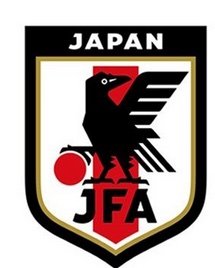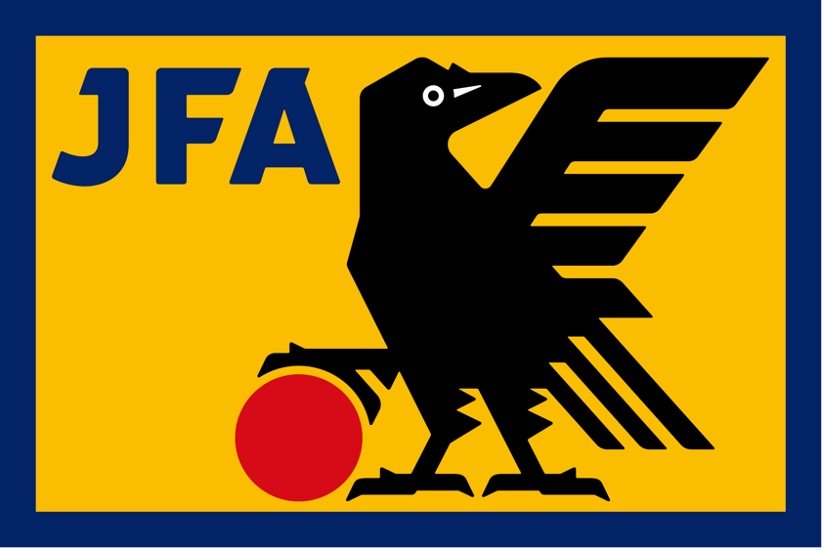Commentary | Or Porath, Something to Crow About: Why Is the Japanese Football Team Logo a Three-Legged Crow?
The Japanese national football team’s shocking triumphs in Qatar over perennial World Cup powers Germany and Spain, before their recent loss in a penalty shoot-out to Croatia in the round of 16, generated waves of excitement in Japan and around the world. As Japan continued its unprecedented run, global newcomers watching the team for the first time may have noted that the players’ Samurai Blue jerseys sport an intriguing symbol. Sitting starkly in the center of the uniform is a three-legged black crow, the tail feathers diagonal black stripes, the wings horizontal. One taloned foot latches onto a red ball, as if the bird itself plays the game—or perhaps even claims for itself the rising sun of the Japanese flag.
The logo of Japan’s football team.
The three-legged crow was not invented by the Japan Football Association (JFA) as the team logo. This fantastical creature appeared in Chinese art for thousands of years, dating back to the Yangshao culture (5000-3000 BCE). Known in China as sanzuwu or yangwu, the crow was a solar symbol whose image adorned fabrics, statues, and imperial robes. The Japanese iteration, recorded since the eighth century, represented a local cult of worship within the deity-centered tradition that coalesced as the religion known as Shinto. In Shinto, animals, plants, objects, and landscapes are inhabited by, or are themselves, kami (gods). These beings pervade the land and its inhabitants with a sacred life-force. The figure in the JFA logo is thus infused by the divine being yatagarasu, or “eight-span crow.”
The Mythic Emperor Jinmu guided by the Yatagarasu (Andatsu Ginko, “Emperor Jinmu's Eastern Expedition”).
Within Japanese traditions, the three-legged crow came to represent the sun and was frequently cast as the messenger of Amaterasu Omikami, the goddess of the sun and ancestor of Japan’s emperors. In the “Chronicles of Japan” (the Nihon shoki of 720, and in a slightly different version in the Kojiki of 712), the yatagarasu appears in a dream to the first Japanese emperor Jinmu. Dispatched by Amaterasu to guide Jinmu and his eastern military expedition in the mountain ranges of Kumano, the yatagarasu flies above and guides the emperor and his troops to the Nara basin, aiding Jinmu in his conquest to establish the Japanese imperial line.
The JFA yatagarasu logo.
The JFA adopted the yatagarasu as its logo in 1931, the same year Japan invaded Manchuria. This was a rout led by a divine cult centered on the emperor, whose authority and divinity legitimized the subsequent conquest of East and Southeast Asia during the Pacific War. The linking of Japanese football with the yatagarasu thus came at a time that saw the alignment of local and imperial Japanese initiatives across Japanese society as private groups sought to capitalize on state discourses of nationalism and imperialism. In the 1930s, as the Kumano Shrine in Wakayama prefecture suffered from population decline, local city officials reinvigorated the site with a focus on touristic expansion. The shrine had previously made the yatagarasu a focal point of worship for hundreds of years, its symbol decorating Kumano’s hallowed grounds and famed pilgrimage routes. It was time to capitalize on their historical and mythological heritage.
There is reason to believe the resuscitation of the shrine may be linked to the JFA decision. Japan’s “father of football,” Nakamura Kakunosuke (1878-1906), was born in Nachi-Katsuura (Kumano), and recently received from his hometown an honorary citizen award as a football pioneer. This happened shortly after the town itself was recognized for its football achievements by the JFA in the 100-year anniversary of the football association in September 2021. The JFA noted in its announcement that they will work to “publicize Mr. Nakamura's achievements throughout the country so that people would visit the Kumano region,” and prided itself on the historical collaboration with the town. Nakamura was also the high-school senior of Uchino Tairei (1884-1953), a football coach (and professor) who designed the JFA logo himself. The Wakayama Furusato archives tout this historical anecdote on their website as the origin for the JFA logo. National sponsorship and local interest in football definitely strengthened and continues to strengthen the relationship between the JFA and Kumano. Given that the linkage between the yatagarasu and national myth, ancient emperors, and the Sun goddess was so deeply ingrained, the three-legged crow became fodder for various nationalists, including those with an interest in sports. The three-legged crow thus blended mythology, imperialism, and sports as it moved from the confines of the shrine onto the football field during the wartime era.
“The three-legged crow thus blended mythology, imperialism, and sports as it moved from the confines of the shrine onto the football field during the wartime era.”
These imperial legacies live on in the present. The Kumano Shrine officials have embraced this complex fusion of mythology, imperialism, and sport. Near the Kumano shrine complex today stands a statue of the yatagarasu, which clutches in one claw not a sun orb but a football, its image modeled on the JFA logo. The complex also houses a statue commemorating the victory of Japan’s women’s football team at the 2011 FIFA Women’s World Cup in Germany. At the nearby Kumano Hongu Shrine are official apparel and T-shirts of Japan’s national soccer team. Both sites host paraphernalia of these victories, treating the items worn by Japan’s athletes as sacred relics. At the foot of the FIFA Women’s World Cup statue are the players’ footprints and signatures, and the Hongu shrine’s worship hall displays autographed jerseys worn at the London 2012 Olympics. Next to a ritual platform are multiple autographed soccer balls displayed in an altar, near the Rising Sun flag of the Imperial Japanese Army, its red orb with sixteen emanating rays evoking Japan’s imperialist past.
Today, the JFA is returning the compliment, selling “protective amulets” (omamori), votive items containing Shinto prayers, on its official JFA Store. Shinto shrines and Buddhist temples across Japan produce and sell such objects, which customers purchase seeking spiritual support for long life, healthy children – and football victories. Designer Nagasaki Himaru produced the first JFA amulet in 2002, the year Japan co-hosted the World Cup with Korea. She recently posted on Facebook about how difficult it had been to get the right shade of Samurai Blue in the embroidery. These amulets will again be produced, adorned with the three-legged crow of the Kumano shrine that in turn replicates the JFA logo. In this moment of jubilation, religion, nationalism, and sports intersect in Japan to form a sacred icon.
Dr. Or Porath is an assistant professor of the Religious Traditions of Japan at Leiden University with broad interests in East Asian religions, the history of gender and sexuality, and monasticism.
To cite this essay, please use the entry suggested below:
Or Porath, “Something to Crow About: Why Is the Japanese Football Team Logo a Three-Legged Crow?,” criticalasianstudies.org Commentary Board, December 12, 2022; https://doi.org/10.52698/GYJN9264.



